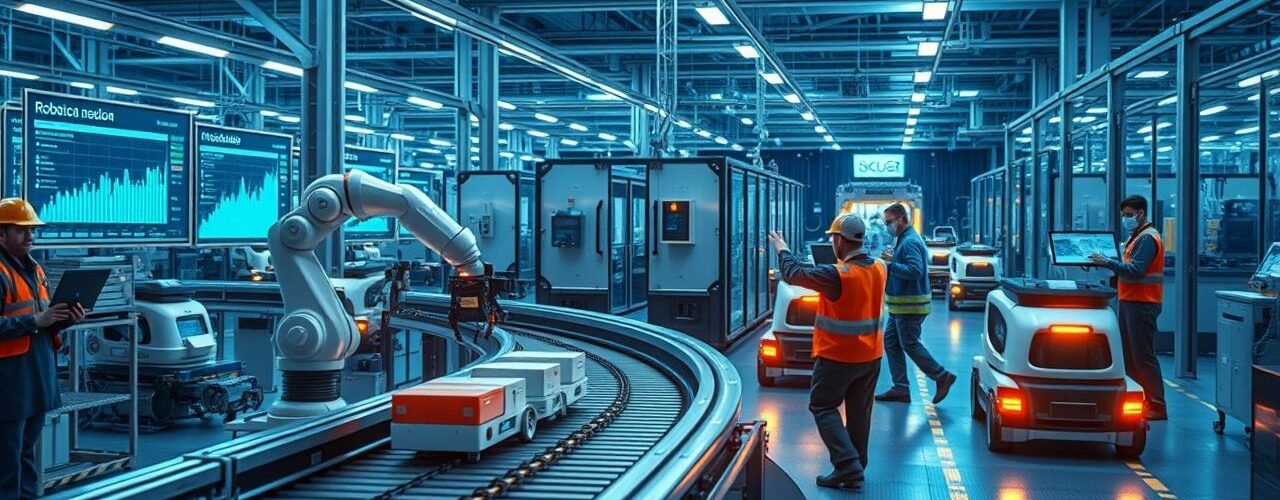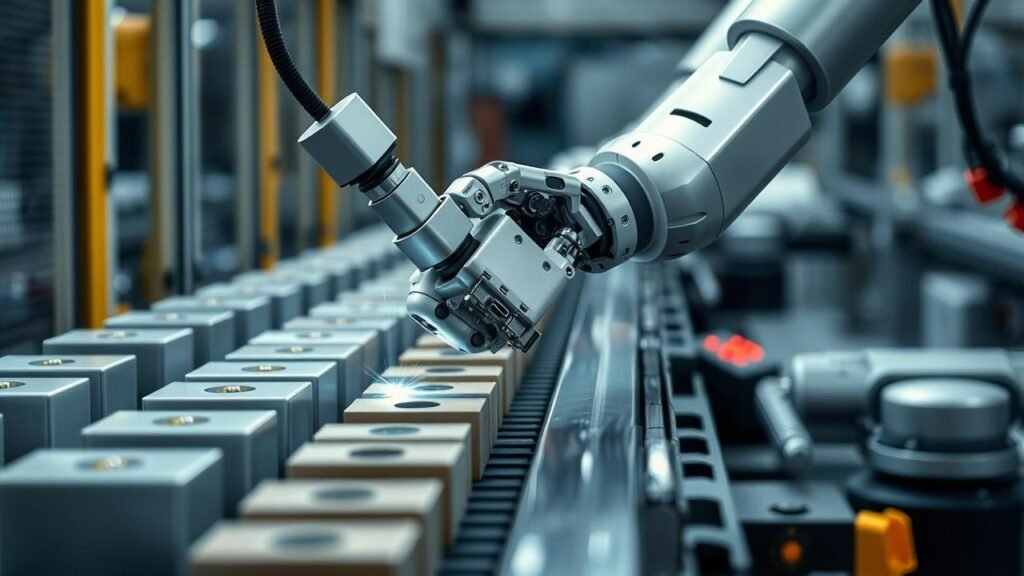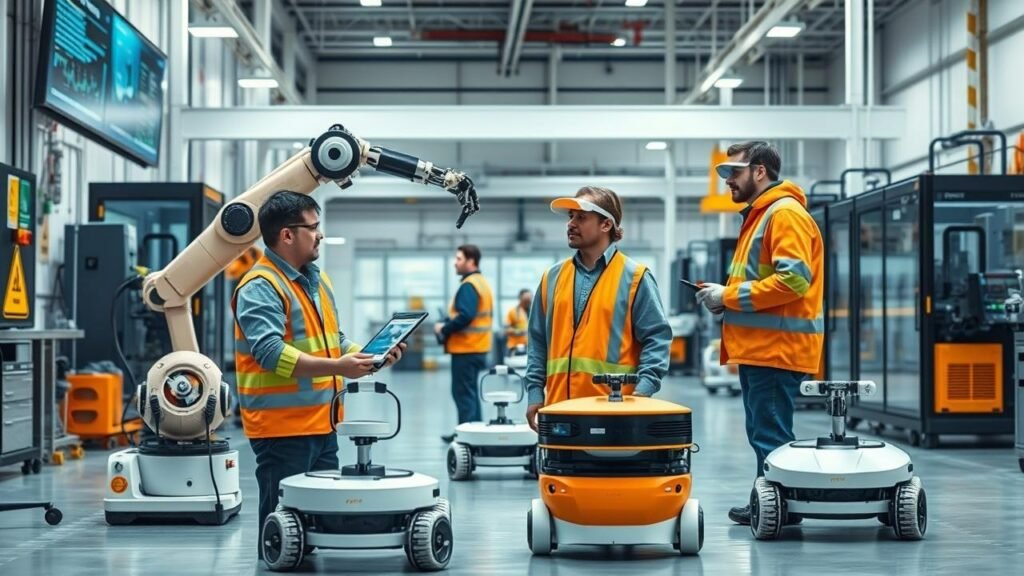The Ultimate Guide to Robotics and Automation: Transforming Industries in 2025

Have you ever wondered how factories produce thousands of identical parts with perfect precision? Or why your online order arrives faster than ever before? Behind these everyday miracles lies the revolutionary power of robotics and automation—technologies that are silently reshaping our world from manufacturing floors to hospital operating rooms.
Robotics and automation represent one of the most profound technological shifts of our time, with the global robotics market expected to reach $214.68 billion by 2030. Whether you’re a business owner looking to streamline operations, a professional navigating a changing career landscape, or simply curious about how these technologies work, this comprehensive guide will walk you through everything you need to know about the robotics revolution happening right now.
Table of Contents
What Are Robotics and Automation: Defining the Digital Workforce
Understanding Robotics
Robotics is the interdisciplinary field focused on designing, building, programming, and operating robots—machines capable of carrying out tasks with minimal human intervention. Unlike simple machines or tools, robots typically possess some degree of autonomy, intelligence, and the ability to interact with their environment.
Modern robots range from industrial arms that assemble vehicles to sophisticated humanoid machines that can walk, talk, and even make decisions. What unites them is their ability to perform physical actions in the real world based on digital instructions and environmental feedback.
Defining Automation
While robotics often involves physical machines, automation refers to the broader process of creating systems that operate with minimal human intervention. Automation can be purely digital (like software that processes insurance claims) or physical (like a conveyor belt system in a warehouse).
The key characteristic of automation is that once set up, these systems can perform complex sequences of operations automatically, often with greater speed, precision, and endurance than human workers.
How Robotics and Automation Intersect
Robotics and automation are deeply interconnected yet distinct concepts:
- All robots incorporate automation, but not all automation requires robots
- Robotics typically involves physical interaction with the world
- Automation can be entirely digital or software-based
- Both aim to reduce human labor for repetitive, dangerous, or precision tasks
Together, these technologies form the backbone of what many call Industry 4.0—the fourth industrial revolution characterized by cyber-physical systems, the Internet of Things (IoT), and smart factories.

The Evolution of Robotics and Automation: From Fiction to Factory
Historical Milestones in Robotics
The journey from science fiction to reality has been remarkable:
- Ancient Concepts: Automatons and mechanical figures appeared in ancient Greek, Chinese, and Arabic writings
- 1921: Karel Čapek introduced the word “robot” in his play R.U.R.
- 1954: George Devol designed the first programmable robot, Unimate
- 1961: The first industrial robot was installed at General Motors
- 1970s: Development of microprocessors enabled smaller, more capable robots
- 1990s: Rise of autonomous mobile robots and early AI applications
- 2000s: Collaborative robots (cobots) designed to work alongside humans
- 2010s: Integration of advanced AI, machine learning, and computer vision
- 2020s: Widespread adoption across industries and emergence of consumer robotics
The Automation Timeline
Automation has followed its own parallel evolution:
- Early 1800s: Mechanized looms transformed textile production
- 1913: Ford’s assembly line revolutionized manufacturing
- 1947: Feedback control systems enabled modern automation
- 1960s: Programmable Logic Controllers (PLCs) revolutionized industrial automation
- 1980s: Computer-integrated manufacturing systems emerged
- 1990s: Software automation began transforming office work
- 2000s: Business process automation gained traction
- 2010s: Robotic Process Automation (RPA) bridged physical and digital automation
- 2020s: AI-powered hyperautomation began connecting previously separate systems
This evolutionary journey has culminated in today’s integrated systems where physical robots, software automation, and artificial intelligence work together across virtually every industry.
Types of Robotics and Automation Systems
Major Categories of Robots
Today’s robotics landscape features diverse specialized machines:
Industrial Robots
- Articulated Robots: Feature rotary joints for complex movements
- SCARA Robots: Precise and fast assembly robots with limited motion range
- Delta Robots: Parallel link robots for high-speed picking and packaging
- Cartesian/Gantry Robots: Move on three axes for precise positioning
- Collaborative Robots (Cobots): Designed to work alongside humans safely
Service Robots
- Professional Service Robots: Used in healthcare, hospitality, and security
- Personal/Domestic Robots: Vacuum cleaners, lawn mowers, and companions
- Entertainment Robots: Used for education and entertainment purposes
Specialized Robots
- Medical Robots: Surgical systems and rehabilitation devices
- Military/Defense Robots: Bomb disposal and reconnaissance
- Agricultural Robots: Harvesting, planting, and monitoring crops
- Underwater/Space Robots: Exploration in extreme environments
Automation Technology Categories
The automation ecosystem is equally diverse:
Hardware Automation
- Fixed Automation: Single-purpose, high-speed production lines
- Programmable Automation: Configurable for batch production
- Flexible Automation: Adaptable to manufacturing variations
Software Automation
- Robotic Process Automation (RPA): Software “robots” that mimic human computer interactions
- Business Process Automation (BPA): End-to-end workflow automation
- Intelligent Automation: AI-enhanced systems that learn and improve
Integration Systems
- Manufacturing Execution Systems (MES): Connect factory floor to business systems
- Supervisory Control and Data Acquisition (SCADA): Monitor and control industrial processes
- Internet of Things (IoT): Connect devices for data collection and remote control
Core Technologies Powering Robotics and Automation
Modern robotics and automation systems rely on several foundational technologies:
Mechanical Components
- Actuators: Motors and hydraulics that create movement
- End Effectors: Grippers, tools, and specialized attachments
- Power Transmission: Gears, belts, and other mechanical systems
Electronic Systems
- Sensors: Vision systems, tactile sensors, proximity detectors
- Controllers: Computers and microprocessors that manage operations
- Power Management: Battery systems and energy optimization
Software and Intelligence
- Control Algorithms: Mathematical models that dictate movement
- Machine Learning: Systems that improve through experience
- Computer Vision: Visual perception and interpretation capabilities
- Natural Language Processing: Human-robot communication capabilities
Connectivity
- Industrial Networks: Protocols for factory communication
- Cloud Integration: Remote monitoring and control capabilities
- 5G Connectivity: High-bandwidth, low-latency communication

Industries Transformed by Robotics and Automation
Robotics and automation are revolutionizing numerous sectors:
Manufacturing
Manufacturing remains the largest adopter of robotics and automation, with applications including:
- Assembly: Precise component placement and joining
- Material Handling: Moving products through production stages
- Quality Control: Automated inspection using vision systems
- Packaging: High-speed sorting and packaging operations
The automotive industry alone accounts for nearly 30% of all industrial robot installations worldwide, with electronics manufacturing following closely behind.
Healthcare and Pharmaceuticals
Medical robotics is transforming patient care:
- Surgical Robots: Enhancing precision in minimally invasive procedures
- Laboratory Automation: High-throughput testing and analysis
- Medication Management: Automated dispensing and verification
- Rehabilitation Robots: Assisting patients with physical therapy
- Care Robots: Supporting elderly and disabled individuals
The da Vinci Surgical System alone has performed over 10 million procedures worldwide, demonstrating the widespread adoption of medical robotics.
Logistics and Warehousing
E-commerce growth has accelerated automation in supply chains:
- Automated Guided Vehicles (AGVs): Transporting materials
- Automated Storage and Retrieval Systems (AS/RS): Managing inventory
- Picking Robots: Selecting items for orders
- Sorting Systems: Directing packages to correct destinations
- Last-Mile Delivery: Emerging autonomous delivery vehicles
Amazon alone operates over 520,000 robotic drive units across its fulfillment centers, handling millions of packages daily.
Agriculture
Farming is experiencing a technological revolution:
- Harvesting Robots: Picking fruits and vegetables
- Autonomous Tractors: Plowing, planting, and field maintenance
- Drone Systems: Crop monitoring and targeted treatments
- Milking Robots: Automated dairy operations
- Vertical Farming: Highly automated indoor agriculture
These technologies are helping address labor shortages while improving yields and sustainability.
Other Key Sectors
Robotics and automation continue to expand into new industries:
- Construction: Bricklaying robots and prefabrication automation
- Mining: Remote operation of equipment in dangerous environments
- Retail: Inventory management and customer service robots
- Food Service: Cooking and preparation automation
- Education: Teaching assistants and administrative automation
Benefits and Impact of Robotics and Automation
Productivity and Economic Benefits
Robotics and automation deliver substantial operational advantages:
- Increased Output: Manufacturing robots can work continuously, often tripling production rates
- Improved Quality: Robots achieve consistency impossible for human workers
- Cost Reduction: Despite high initial investment, long-term operational savings are significant
- Labor Augmentation: Workers can focus on higher-value tasks while robots handle repetitive work
- Workplace Safety: Dangerous tasks can be delegated to machines, reducing injuries
A Boston Consulting Group study found that companies implementing advanced robotics can reduce conversion costs by up to 15% and increase productivity by 10-20%.
Workplace Transformation
The integration of robotics and automation is reshaping work environments:
- New Job Categories: Creating positions like robot programmers and automation specialists
- Skill Enhancement: Workers develop technical competencies to manage automated systems
- Collaborative Environments: Humans and robots working together as teams
- Remote Operations: Enabling control of systems from anywhere
- Flexible Manufacturing: Allowing smaller batch production economically
Social and Economic Considerations
The robotics revolution also presents important societal challenges:
- Labor Market Shifts: Some jobs disappear while others are created
- Educational Requirements: Need for STEM education and technical training
- Economic Inequality: Risk of benefits flowing mainly to capital owners
- Geographic Impacts: Manufacturing reshoring and changing regional economies
- Small Business Access: Democratization of technology through affordable solutions
Implementation Strategies for Robotics and Automation
Successful adoption requires careful planning and execution:
Assessment and Planning
Before investing in robotics and automation:
- Process Analysis: Identify which operations could benefit most
- ROI Calculation: Determine expected financial returns
- Technical Feasibility: Assess if current technology can meet needs
- Implementation Timeline: Create realistic deployment schedules
- Risk Assessment: Identify potential challenges and contingencies
Integration Approaches
Implementation can follow several paths:
- Pilot Programs: Starting with limited deployment to prove concepts
- Phased Implementation: Gradually expanding automation across operations
- Rip and Replace: Complete overhaul of existing systems
- Hybrid Integration: Combining new automated systems with legacy operations
- Collaborative Implementation: Involving workers in the design and deployment process
Change Management
The human element is crucial for successful implementation:
- Communication: Clearly explaining the purpose and benefits
- Training Programs: Developing necessary skills among existing staff
- Job Redesign: Redefining roles to complement automation
- Cultural Adaptation: Creating a technology-positive environment
- Ongoing Support: Providing resources for continuous learning
Future Trends in Robotics and Automation
The field continues to evolve rapidly, with several emerging trends:
Technological Advances
Next-generation capabilities are emerging:
- Advanced AI Integration: Self-learning systems that adapt to changing conditions
- Soft Robotics: Flexible materials enabling delicate object manipulation
- Swarm Robotics: Coordinated multi-robot systems working together
- Edge Computing: Processing data locally for faster response times
- Digital Twins: Virtual replicas for simulation and optimization
- Neuromorphic Computing: Brain-inspired architectures for more efficient processing
Emerging Applications
New use cases continue to develop:
- Micro and Nano Robotics: Microscopic machines for medical and industrial applications
- Environmental Remediation: Robots cleaning oceans and managing waste
- Disaster Response: Autonomous systems for dangerous rescue operations
- Elderly Care: Addressing demographic challenges with assistive technologies
- Space Exploration: Enabling missions beyond human capabilities
- Autonomous Infrastructure: Self-maintaining urban systems
Ethical and Regulatory Developments
Important governance frameworks are evolving:
- Safety Standards: ISO/TS 15066 and similar frameworks for collaborative robots
- AI Ethics: Guidelines for responsible automation decision-making
- Data Privacy: Regulations addressing information collected by automated systems
- Liability Frameworks: Determining responsibility for autonomous system actions
- International Coordination: Global approaches to consistent regulation
Case Studies: Robotics and Automation Success Stories
Manufacturing Transformation: BMW Production
BMW’s Spartanburg plant demonstrates the power of collaborative robotics:
- Challenge: Need to maintain quality while increasing production flexibility
- Solution: Deployed over 2,000 robots including collaborative systems
- Implementation: Phased approach integrated with existing workforce
- Results: 50% increase in production capacity, reduced ergonomic issues for workers
- Lessons: Successful integration requires worker involvement and continuous training
Healthcare Innovation: Pharmacy Automation at Cleveland Clinic
Cleveland Clinic revolutionized medication management:
- Challenge: High-volume medication dispensing prone to human error
- Solution: Implemented robotics for prescription filling and verification
- Implementation: Centralized system serving multiple facilities
- Results: 0.00006% error rate (compared to 0.5% nationally) and labor redeployment
- Lessons: Automation can simultaneously improve safety and economics
Agriculture Revolution: Strawberry Harvesting Robots
California berry producers addressed labor challenges:
- Challenge: Labor shortage for delicate fruit harvesting
- Solution: Vision-equipped robots for strawberry picking
- Implementation: Initially supplementing human workers, gradually expanding
- Results: 30% reduction in harvesting costs, extended picking hours
- Lessons: Even complex tasks previously thought impossible to automate are becoming feasible
Common Challenges in Robotics and Automation Adoption
Despite their benefits, implementation faces several hurdles:
Technical Challenges
- Integration Complexity: Connecting new systems with existing infrastructure
- Data Management: Handling the vast information generated by automated systems
- Maintenance Requirements: Developing preventive maintenance capabilities
- Customization Needs: Adapting generic solutions to specific applications
- Technical Debt: Managing obsolescence in rapidly evolving technologies
Economic Barriers
- High Initial Cost: Substantial capital investment required
- ROI Timeline: Extended payback periods for some applications
- Operational Disruption: Productivity impacts during implementation
- Training Expenses: Developing workforce capabilities
- Scaling Challenges: Moving from pilot to full implementation
Human and Organizational Factors
- Resistance to Change: Worker concerns about job security
- Skill Gaps: Lack of technical expertise for management and maintenance
- Safety Concerns: Ensuring human-robot collaboration safety
- Organizational Structure: Need for new roles and responsibilities
- Cultural Adaptation: Shifting from traditional processes to technology-driven approaches

How to Get Started with Robotics and Automation
Whether you’re a business leader or individual looking to enter the field:
For Businesses
- Start Small: Begin with well-defined projects that offer clear ROI
- Partner with Experts: Engage integrators and consultants for initial implementation
- Prioritize Training: Invest in developing internal capabilities
- Create a Roadmap: Develop long-term automation strategy aligned with business goals
- Measure Results: Establish clear metrics to evaluate success
For Professionals
- Educational Pathways: Degrees in robotics, mechatronics, or related fields
- Certification Programs: Industry-recognized credentials for specific technologies
- Practical Experience: Hands-on projects using development platforms
- Community Engagement: Participation in robotics competitions and forums
- Continuous Learning: Staying current with rapidly evolving technologies
Frequently Asked Questions About Robotics and Automation
Will robots replace human workers entirely?
While automation will certainly change the nature of work, complete replacement of humans is unlikely. History shows that technology tends to create new job categories even as it eliminates others. The most likely outcome is increased human-robot collaboration, with machines handling repetitive or dangerous tasks while humans focus on creative, strategic, and interpersonal work that requires uniquely human capabilities.
How much does implementing robotics and automation cost?
Implementation costs vary dramatically based on scale and complexity. A simple collaborative robot arm might cost $30,000-50,000, while a comprehensive factory automation system could run into millions. However, costs continue to decrease as technology matures, with ROI timelines shortening. Additionally, new business models like Robots-as-a-Service (RaaS) are making automation accessible to smaller businesses without large capital investments.
What industries will see the biggest robotics impact in the coming years?
While manufacturing will continue leading adoption, healthcare, agriculture, and logistics are poised for dramatic transformation. Construction, retail, and food service are also seeing accelerated implementation. Generally, any industry with repetitive tasks, labor shortages, or safety concerns represents strong potential for robotics and automation growth.
How can small businesses benefit from automation?
Small businesses can adopt targeted automation solutions like:
- Collaborative robots for specific production tasks
- Software automation for administrative processes
- Semi-automated equipment for specific operations
- Subscription-based automation services
- Industry-specific solutions designed for smaller operations
The key is identifying high-impact processes where even limited automation can deliver meaningful benefits.
What skills will be most valuable in an automated future?
As robotics and automation expand, several skill categories become increasingly valuable:
- Technical skills: Programming, system integration, and maintenance
- Creative problem-solving: Identifying opportunities for automation
- Data analysis: Interpreting information from automated systems
- Human-machine collaboration: Working effectively alongside robots
- Adaptability: Continuous learning as technologies evolve
Conclusion: Embracing the Robotics and Automation Revolution
Robotics and automation represent one of history’s most significant technological transformations—comparable to the original industrial revolution in its far-reaching implications. For businesses, these technologies offer unprecedented opportunities to improve productivity, quality, and safety. For workers, they present both challenges in transitioning roles and opportunities to engage in more meaningful work as machines take over repetitive tasks.
The key to successful navigation of this technological shift lies in thoughtful implementation that considers not just technical capabilities but human factors as well. The most effective robotics and automation deployments augment human capabilities rather than simply replacing them, creating collaborative environments where technology and people each contribute their unique strengths.
As we look to the future, continued advances in artificial intelligence, materials science, and computing will further expand the capabilities and applications of robotics and automation. Organizations and individuals that develop the knowledge and flexibility to adapt to these changes will be best positioned to thrive in an increasingly automated world.
The robotics revolution isn’t coming—it’s already here. The question isn’t whether these technologies will transform our economy and society, but how we can harness them to create the greatest benefit for all.


